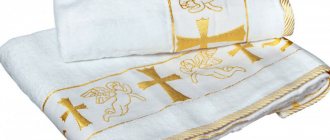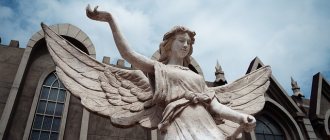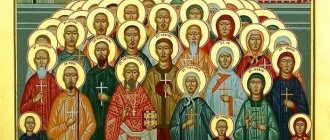The name Ivan in the Saints
There are 2 equivalent name forms recorded in the Saints: Ivan (91 times) and John (37 times).
Meaning of the name
Ivan is the Russian-pronounced biblical name John, which comes from the Hebrew Yochanan.
It has a number of meanings: “Yahweh had compassion,” “Yahweh had mercy,” “the grace of God,” “God’s gift” (Yahweh is the name of God). In other languages, the name sounds like this: Ivan, Evan, Johvan, John, Juan, Jan, Jonas, Giovanni, Hans, Johann, Jean.
Main features
Independence, thoroughness, self-esteem and independence characterize Ivan from the positive side.
Character
Ivan is associated with a stupid fairy-tale hero, who turns out to be the smartest. As a child, the boy suffers from ridicule (Vanka-Vstanka, Ivanushka the Fool), enters into conflicts, but knows how to withstand and even establishes himself in the team. At the same time, complexes associated with childhood grievances rarely develop. The following parallels can be drawn with the unlucky hero of fairy tales:
- The real Vanya and the literary character do not strive for leadership.
- They know how to fight back against an offender.
- Both are good-natured, generous, and not vindictive.
- Hardworking and resilient.
- Generous, smart.
- They are on their own: they always follow their own calculations.
- They do not pay attention to ridicule, they persistently go towards their intended goal, even when fate throws them in the way.
Ambition is inherent, but does not appear outwardly. Ivan is building a career to gain a high status in society, and not to command. He demands respect from those around him.
Women love men with this name for their charm and gallantry. These are reliable husbands, economical, who know how to provide for their family.
The inconsistency of character lies in the fact that Ivan is a supporter of traditions, a keeper of values, but does not like everyday routine, and is inclined to change hobbies. He is good-natured, but can flare up; external restraint coexists with impulsiveness, and fearlessness with indecision.
On the anniversary of the canonization of Saint Righteous John of Kronstadt
Approximate reading time: 10 min.
Korney Chukovsky has a wonderful riddle in verse: Maryushka, Marusenka, Mashenka and Manechka
We wanted a sweet sugar gingerbread.
An old grandmother was walking down the street,
Grandmother gave the girls money.
. And Kondrat thought, looking from the corner;
Did grandma give you a lot of kopecks?
The answer is obvious. One. Although it seemed that there were at least four girls. Another surprising thing is why Korney Ivanovich did not compose a “male version” of this riddle, why did he not use his native and such “Russian” name Ivan in his poetic experiments? After all, the poem would then be more intricate: Jan, Jean, Giovanni and Johann, Juan, John, Hans, Jens, and Johan, Vano, Sean, Vacek and a couple more names. However, jokes aside. Agree that it is difficult to find another name that has a place absolutely all over the world, would be popular and sound so different, so dissimilar.
In the domestic popularity rankings, the name Ivan has always been in the top ten. But it was never the first, even if the Russian tsars were called by this name. Perhaps because, thanks to folklore, the name has a certain connotation. In Russian culture, Ivan to this day remains a collective image of an entire people, even a common noun. So during the Second World War, the opposing side called all Russian soldiers Ivans. In turn, Russian soldiers, as well as the Soviet press, referred to the Germans exclusively as Krauts. In this “Fritz” (a diminutive form of the name Friedrich) it sounds quite sharp and even rude to our ears, as if a derogatory attitude towards the enemy was emphasized. I wonder how the German ear hears “Ivan”?
Another stable expression that arose in Tsarist Russia was “Ivan, who does not remember his kinship.” Fugitive peasants and convicts, caught by the police and naturally without passports, hid their origins. They often called themselves Ivans. And when asked where they came from, what places they came from, they answered that “they don’t remember.” So an entry began to appear in the documents, which over time turned into a stable expression and even the surname Nepomniachtchi. Until now, the phraseological unit “Ivan, who does not remember his kinship” is often used as a collective image in relation to Russians who do not know their own tradition, history and culture.
At the beginning of the 18th century, Peter I regulated the recording of names in official documents. According to the decree, names in documents should be strictly in accordance with the recording of the name at baptism. And then the everyday, popularly accepted and incredibly popular form of the name John, like Ivan, became the official name. The name John has been preserved in church usage. But, despite numerous reforms, differences in writing continued to exist. And only in 1891, when the synodal printing house of St. Petersburg published an official calendar, distributed among all parishes, with instructions to name children strictly according to the calendar, uniformity was established for a while. It didn't last long. The revolution and the subsequent 1918 decree on the separation of church and state changed the naming procedure for children. This was now the responsibility of the registry office departments. At the same time, those who tried to give names to children in the old fashioned way were subjected to public condemnation and ridicule. And many names were publicly declared “philistine” and “old regime.” Strangely enough, the name Ivan was included in this list. That is why from the twenties until the sixties there was a slight decline in interest in the name Ivan.
The Russian Orthodox Church Outside of Russia canonized John of Kronstadt thirty-six years earlier, on November 1, 1964.
Ivan's name day according to the Orthodox calendar
In Orthodoxy, there are 120 days of honoring the memory of saints named John, but each man named Ivan has his own heavenly patron, in whose honor the name day is celebrated. This date in the calendar is the nearest Remembrance Day of the named saint.
It is impossible to list all the saints with the name John in this article. Here is a list of the most revered, with days of celebration:
- John the Baptist (Forerunner): January 20, March 9, June 7, July 7, September 4, October 6 and 25.
- John the Theologian: May 21, October 9.
- John Chrysostom: February 9, November 26.
- John of Kronstadt: January 2, June 14.
- John of Thessalonica: April 24, May 1.
If the patron saint is venerated more than once, the name day is celebrated on the date closest to the birthday (counted forward according to the calendar), but it can also be celebrated on other days of remembrance.
Apostle John the Theologian, memorial dates: May 21, July 3 and 13, October 9
This name was borne by the apostle and evangelist John the Theologian. He was the son of Zebedee and Salome (daughter of Joseph the Betrothed). The Lord called John, along with his brother James, to be one of his disciples.
The Savior especially loved the Apostle John, for this he was one of the three disciples whom Jesus Christ especially brought close to himself. He was honored to see the resurrection of Jairus’s daughter, the Transfiguration of the Lord on Mount Tabor, during the Last Supper he was next to Christ and, at a sign from the holy Apostle Peter, asked Him who the traitor was.
The Holy Apostle John followed the Lord, while He was being led from the Garden of Gethsemane to the trial of Caiaphas and Anna, and he did not retreat from the Lord on the Way of the Cross.
Together with the Mother of God, he lamented and cried at the foot of the Cross. After the death of the Savior, he, like a caring son, took care of the Most Holy Theotokos. He was in Jerusalem all the time next to the Blessed Virgin until her dormition.
After this, he went to Ephesus to preach the Gospel together with his disciple Prochorus. During the crossing, a strong storm arose at sea. All passengers were thrown to the ground, except the holy apostle. His disciple was greatly grieved and lamented. But he decided to go to Ephesus, as planned.
On the fourteenth day of his journey, Prokhor stood on the shore and suddenly saw that a man had been thrown onto the shore by a wave. It was the Apostle John. The Lord saved his life, and he spent fourteen days under water.
Then the saint was exiled to the island of Patmos. Here he lived for many more years. On his way there, he performed many miracles. On the island, the apostle continued to preach, cast out demons, and healed the sick. A lot of people received holy Baptism. But even on the island of Patmos, pagan forces resisted the spread of Christianity in every possible way. The sorcerer Kinops even promised that he would kill the Apostle John. But the saint, by the power of grace, destroyed all the tricks of the pagan, who as a result drowned.
He lived on earth for more than 100 years, becoming the only person by that time who saw Christ. When the time came for the transition to Eternal Life, the Apostle John withdrew outside the city with his disciples. He asked them to dig a coffin in the ground in the form of a cross. The saint lay down in it, telling the disciples to begin covering it with earth.
The disciples fulfilled his request; when his other followers found out about this, they immediately arrived at the burial place of the apostle. They dug up the grave, but there was no body in it.
Icon of the Apostle John the Theologian
Very often boys are named John in honor of the Holy Prophet and Baptist John. John the Baptist is the most revered saint after the Virgin Mary. The following holidays were established in his honor: October 6 - conception, July 7 - Christmas, September 11 - beheading, January 20 - Council of John the Baptist in connection with the feast of Epiphany, March 9 - the first and second discovery of his head, June 7 - third discovery his chapter, October 25 is the celebration of the transfer of his right hand from Malta to Gatchina (according to the new style).
The Prophet John the Baptist was born into the family of the priest Zechariah and the righteous Elizabeth, who for many years prayed to God to give them children. And then one day the Archangel Gabriel appeared to Zechariah in a dream and announced the birth of his son.
The future prophet John was a relative of the Lord Jesus Christ on his mother's side and was born six months earlier than him. By a miracle of God, the baby escaped death during the massacre of infants in the city of Bethlehem.
Saint John grew up in the desert. From a young age, with the strictest fasting and prayer, he prepared himself for righteous service. When he turned 30 years old, the Lord called him to preach to the Jewish people.
Prophet John addressed the people on the banks of the Jordan River, where many people had come for religious ablution. But the saint said that not only external cleansing is important, but, first of all, moral. We need to prepare ourselves to accept the Gospel and meet Christ.
John received a revelation about the Lord, so he told the people: “Behold the Lamb of God, who takes away the sins of the world.”
At the celebration of Herod's birthday, Salome, the daughter of Herodias, staged wicked dances. The king liked them so much that he promised to give her everything she asked. Salome asked him for the head of John the Baptist (her mother talked the girl into this). Moreover, the head had to be served on a platter.
Herod sent a guard to the prison where the prophet was sitting and ordered Salome's wish to be fulfilled. The order was immediately carried out. Herod gave the head of the prophet John to the dancer, and she gave it to her wicked mother Herodias. She decided to abuse the severed head and threw it into a dirty place.
The disciples of John the Baptist preserved the body of the saint and buried him in the city of Sebastia.
Icon of the Prophet John the Baptist
The holy head of John the Baptist was found by the pious Joanna. She buried her in a vessel on the Mount of Olives. Later, one of the ascetics dug a ditch at this place to lay the foundation of the temple. He found this shrine. He kept it for a long time, but before his death, in order to hide it from disgrace by non-believers, he buried it again in the same place.
During the reign of Constantine the Great, two monks came to Jerusalem. They wanted to worship the Holy Sepulcher. The prophet John appeared to one of them. He pointed out where his head was buried. From that time on, Christians began to celebrate the First Finding of the Head of John the Baptist.
About the prophet John the Baptist, the Lord Jesus Christ said: “Among those born of women there has not arisen a greater (prophet) than John the Baptist.” John the Baptist is glorified by the Church as “an angel, and an apostle, and a martyr, and a prophet, and a candle-bearer, and a friend of Christ, and a seal of the prophets, and an intercessor of old and new grace, and the most honorable and bright voice of the Word among those born.”










